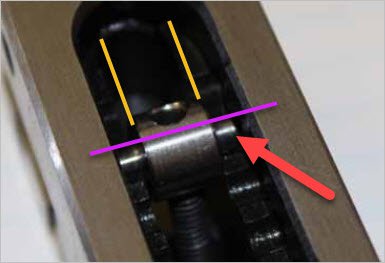The vise knuckles vary in their mechanism, but I can elaborate on the modification I did on my vises using this pic example. It vastly improved it over the stock one which was hopelessly useless. Strange, a very precision made vise, hardened & ground on all surfaces to high spec. And then this POS for the mechanism. But I digress...
- yellow lines = increased the knuckle width so it had a nice sliding fit. Stock one was undersized so waggled back & forth in the slot. Had to clean up slot with a small grindstone because of raised burrs from the detents. Unfortunately they didn't clean this up before hardening & this also some explained some hangups here & there but not everywhere.
- pink line = knuckle diameter relative to base. When the vise is in normal upright position, this flops down & rests/slides along the table surface top, so diameter affects much the knuckle pins are under detent entries. Stock one was too skinny so you had to unwind screw many turns to clear detent, move into position, then screw in again. Now I only have a few turns between loosen & clamp. And it finds the right detent better.
- arrow = extended boss diameter relative to detent diameter. Stock one was undersized so never felt like it was engaging properly & felt squishy when tightening. Maybe 0.005" undersized to detent ID worked fine, much more solid.
My bigger vises have a ball end mill dish shaped profile under the bolt head & then either a similarly profiled washer or profiled bolt. On this teeny vise its too small for washer so just a bit of round over under the bolt head & but it snugs fine. I could give dimensions but it would only be specific to this teeny vise. Anyway the combination of all the above made it much nicer to use. That pin-though-the hole style might benefit from some of these mods to better pre-align & pre-position the knuckle? Like I said, a bit of fiddle work & these can become very useful tools & a lot more accurate than some of the big cast milling vises that seem to vary in quality. In a real machine shop they are probably more common on a surface grinder. But for the price, why not use it on a mini mill?

